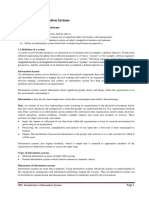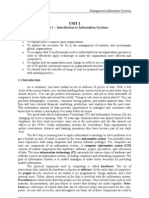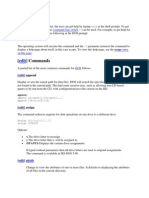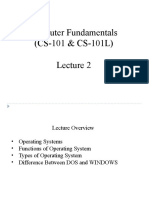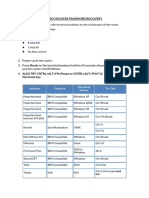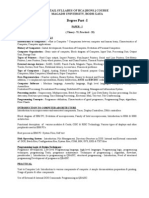Lesson 4: Organization and Information Systems: Objective
Lesson 4: Organization and Information Systems: Objective
Uploaded by
dearsaswatCopyright:
Available Formats
Lesson 4: Organization and Information Systems: Objective
Lesson 4: Organization and Information Systems: Objective
Uploaded by
dearsaswatOriginal Title
Copyright
Available Formats
Share this document
Did you find this document useful?
Is this content inappropriate?
Copyright:
Available Formats
Lesson 4: Organization and Information Systems: Objective
Lesson 4: Organization and Information Systems: Objective
Uploaded by
dearsaswatCopyright:
Available Formats
MANAGING INFORMATION SYSTEM
LESSON 4: ORGANIZATION AND INFORMATION SYSTEMS
Objective
The objective of this lesson is to give you an Insight into:
The role of information technology in building Information
system.
The limitations of information technology. The meaning of organization. The relationship between organization and Information
It does not include just hardware, but also in software and the people who are using these softwares to connect to the hardware. Training people, building new operating procedures around technology, and changing work processes take far longer time than the technological pace will allow.
Role of Information Technology
Now its time to understand the role of information technology in out basic life. What makes us moving? What is the thing that has changed the looks of world? Whats the entity that has partitioned the world between the developed and underdeveloped countries? What makes this fact world moving? If I am not wrong, sometime you all or at least some of you must have given a thought to it. So do you have answer with you? Well, the answer is Technology. Even though the Internet as a whole has existed since 1969, the World Wide Web didnt exist until around 1993-1994, thats less than 10 years. Now you cant pick up a magazine or a newspaper, turn on the television or radio, even drive by a billboard without some kind of reference to dot com. Business are rushing to the Internet in an effort to keep up with the competition or to create whole new range of businesses. Now organizations struggle with such issues as how to design and develop a Web site or how to determine fair email policies of employees. Lets take an example in respect to Indian economy. You will be surprised to know that Internet came to India on 15th August 1995. Videsh Sanchar Nigam Limited (VSNL) A Government of India Enterprise, introduced it at that time. Only a few people used the facilities of Internet during few people used the facilities of Internet during its introductory years, and within a decade, its user base shot up to millions of people all over the country. This shows the impact of Technology.
technology.
Introduction
By now I suppose that you would agree with me to the fact that in todays world managers cant be ignorant to technology any more and depend on secretaries or clerical workers or the Information Technology department. Information technology or more specifically the role of computer plays a vital role in every part of our life. Youll be surprised to know that usage of information systems came into existence only a few decades back and strengthened its stance with the introduction of computers. Technology and its associated Information Systems are now integrated throughout the organization. Everyone is concerned about technologys role and impact on their work activities. End users take on greater responsibilities for making Information System a success and are actually doing all the work that was once the responsibility of the technical staff. Even the people working at the executive levels of an organization can no longer ignore the technology and pretend that it is the job of someone else. We are constantly bombarded with new tools and technologies, and innovative methods of handling business. It almost seems as that you have to learn a whole new range from scratch, just as you master a word processing program. But the fact is that the organizations, especially larger ones, just cant change so fast to adopt and upgrade the technology in their organization. Companies make huge investments on the technological part.
Challenges for Information Technology
Now lets throw some light on the limitations of information technology. Is this new technology worth the headaches and heartaches associated with all the problems that can and will arise? Yes, the opportunities for success are endless. The new technologies do offer solutions to age-old problems. Improvements are possible to the way you operate and do business. The challenges, which are thrown by information technology, can be classified as:
The Strategic Business Challenge: Companies spend
thousands of dollars on hardware and software, only to find that most of the technology actually goes unused. How can that be? This is usually because they dont pay attention
Copy Right: Rai University 10 11.302
MANAGING
to the full integration of the technology into the organization. Merely buying the technology without exploring the new opportunities it offers for doing better. Change is inevitable, and information must be managed just as you would manage any other resources.
The Globalization Challenge: The world is becoming
smaller every day. Competition increases among countries as well as companies. A good Management Information System meets both domestic and international opportunities and challenges.
The Information Architecture Challenge: You have to
tion technology will help the three levels of management in that industry to achieve these goals. These goals are normally planned when organization is to be started. Out of the goals some are explicit (i.e. recognized and understood by everybody in the organization). But some of these goals are implicit (i.e. they are recognized whenever the organization is to be started. Out of these goals some are explicit (i.e. recognized and understood by everybody in the organization). But some of these goals are implicit (i.e. they are recognized whenever the organization is in the development process). Organizations achieves these goals keeping in mind the following point
Vision: Members of the organization often have some
INFORMATION SYSTEM
decide what business you are in, what your core competencies are, and what the organizations goals are. Those decisions drive the technology, instead of the technology driving the company. Purchasing new hardware involves more than just taking the machine out of the box and setting it on someones desk. Remember the triangle of hardware, software, and people ware. Take care of the people and they will take care of the rest! Information architecture describes how to incorporate technology into the mainstream processes in which the business is involved. How will the new Information System support getting the product produced and shipped? How will Advertising and Marketing know when to launch ad campaigns? How will Accounting know when to expect payment?
The Information Systems Investment Challenge:
image in their minds about How the organization should be working and how it should work when things are going well and in adverse situation.
Mission: An organization operates according to the purpose
and mission.
Values: All organizations operate according to some values
and priorities in order Carry out their activities. These values identify the personality and culture of the organization.
Strategies: Organizations follows several general approaches
and methods to Reach their goals. These approaches and methods are called as strategies of the organizations.
Managers often look at their technological investments in terms of the cost incurred on hardware or software. They over look the costs associated with the non-technical aspects of technology. Is productivity up or down? What is the cost of lost sales opportunities and lost customer confidence from a poorly managed E-Business Web site?
An Organization
Relationship between an Organization and IS
There exists a two-way relationship between an organization and information system. This relationship can be elaborated in the following diagram. You can find out the complexity of the relationship between organizations and information technology from the above figure. Installing a new system or changing the old one involves much more than simply installing down new terminals on everyones desk. The greatest influence, as the text points out, could simply be sheer luck!
Now since we have discussed a lot on organization, so lets take on flash overview of an organization. To visualize an organization you can take an example of Hindustan Lever Limited (HLL), which has captured prominent market share in percentage terms with respect to house hold commodities.
Definition : Organization
Basically, an organization is a group of people intentionally organized to accomplish an overall, common goal or set of goals. Business organizations can range in size from two people to ten of thousands. This group of people has gathered together for achieving the goals they have set. These people work hard and coordinate together. How do you determine if your Management Information System is worth it?
The Responsibility and Control Challenge: Remember,
How organizations Affect Information Systems
Change is the only constant in the relationship between information systems and organizations. You need to consider:
How have organizations in reality use information systems? How did the organizational role of information systems
change?
Who operates information systems? Why do organizations adopt information systems in the
humans should drive the technology, not the other way around. Too often we find it easier to blame the computer for messing up than to realize that its only doing what a human being asked it to do. Your goal should be to integrate the technology into the world of people. Humans do control the technology, and as a manager, you shouldnt lose sight of that. Activity 1: Choose a service industry (e.g. health care, NGO, Fire Department etc.) and put down the points in which informa-
first place?
Decisions about the Role of Information Systems.
When we look back the Information Systems that existed years ago, it consisted of a huge mainframe computer with a few terminals connected to it. You had to schedule a specific time to use the computer if your company had one at all. All data were kept on one machine, and in some respects the data were available to whoever could access them.
Copy Right: Rai University 11.302 11
MANAGING INFORMATION SYSTEM
When personal computers were introduced in the early 1980s, it became the norm for most people to have individual computing islands on their desks. The computers werent connected, so if you wanted to exchange data or information, you had to somehow get the data from your desk to the other persons desk. It wasnt easy. Now it seems weve come full circle: weve combined the storage and data processing on a central machine with personal computing available on desktops. The data are available to anyone who can use them or has authorized access through a network with links literally all over the world. The changes that have taken place in computing have affected the business environment in a big way. Over 40% of the equipment investment in the last decade has been for computing equipment. Organizations are finding more efficient ways to accomplish tasks via networking, either through internal networks or by connecting to external networks. Technology has caused many changes in the way business connect to customers and suppliers. Well examine many of these changes throughout this course.
changes to the electronic version of the file and return it to the assistant. Already weve saved a part of a tree! Of course other in the organization must review the new dress code policy. The proposed policy can be printed in fifteen copies, and a person can manually send the copies out, track where they went and when, and then track all the changes made to the proposal. Or, the proposed policy can be sent electronically to reviewers who will electronically collaborate on necessary changes. Each of the reviewers can see n real time what the others think and the changes they would like to make. Weve saved another part of the tree in reducing the use of paper. In this context, we have also saved a lot of time and effort. Once the policy is set, it has to be sent to each of the employees. We could do that through the old method of printing hundreds of copies. Or we could send the policy to each person electronically (through email). Everyone would have a personal copy stored on his computer. Theyre no need to print a copy of it on the paper since it will be stored electronically and can be accessed whenever it is convenient. By acknowledging receipt of the policy via email, the HR department knows everyone has received it. So what about the people who dont have their own personal computer? You could post the new policy to the company Intranet, which would be available to all employees whenever they find it convenient. Again, time and resources are cut drastically through the use of an Information System. If the policy needs to be revised, the same process can be used to make and send out changes. The revised policy can be posted on the Intranet for all to see. This is just one example of how technology is helping organizations reduce the costs of doing business. The transaction cost theory supports the idea that through technology, businesses can reduce the costs of processing transactions with the same zeal that they use to reduce production costs. One way that technology in general, and information systems in particular, save companies a lot of money in the reduced number of managers needed to oversee larger numbers of workers. The technological changes support agency theory, which says that owners hire agents to do work but then must have others supervise the agents to be sure they work in the companys interest. Technology allows a manager to supervise more employees, thus reducing agency cost.
Behavioral Theories: Technology doesnt automatically
Need For Up gradation
Everybody has a common kind of a question framed into their mind, after learning the benefits of information technology. The question is How information technology will help my organization or How can I increase the productivity and finally the profits after implementing information systems effectively. Being as an efficient manager of an organization, you must draft out the strategy for the same. Let me explain it to you in following way: Organizations incorporate technology for many reasons. The most obvious reason should be to save money through improved work processes and reduced manpower requirements, and to beat the competition. This is what we have discussed in the beginning on the section.
How Information Systems Affect Organizations?
To solve this very important question of yours, lets take up help from two major types of theories economic and behavioral theory respectively.
Economic Theories: Its sometimes cheaper to hire a
computer than to hire a Person. We may not like the idea that machines can replace human beings, but when you think about it, they have been doing this for thousands of years (microeconomic model). To better illustrate you this concept, let us take a look at how a company can find it cheaper to use an Information System to develop and disseminate a Human Resources policy regarding dress codes for employees. The HR assistant many write the first draft of the policy and give it to the HR director on paper. The director will review it and make changes. The assistant then must incorporate the changes and reprint the document. Wait! If there is an Information System, the assistant can submit the draft to the director electronically and the director can make
transform organizations. There is no magic wand companies can wave and have all their problems solved just because they install the latest information system. People using technology efficiently and effectively, however, can transform organizations. Communications up and down the organization and from one department to another on the same managerial level can be enhanced and increased by using technology. As our example with the dress code policy shows, communications are much faster and better using technology. The lines of communication are shorter, clearer, and more concise.
Copy Right: Rai University 12 11.302
MANAGING
Technology makes virtual organizations more feasible, cheaper, and easier to set up and tear down than before. If you had a small group of people from each functional area of the company collaborating on a new production method, you can bring them together, hammer out the new methodology, and then return them to their regularly assigned units. Lets your company decides to develop a new method of shipping hammers. You would need to draw people from the Production department, the Shipping department, the Packaging department, and the Accounting department to help develop the new procedures. Without an Information System, you would need to have a clerical worker available to record and send out all the information to everyone before and after the meetings. You would have to set up a time and place for team members to meet. Scheduling everyones time is often a nightmare! Because of the political nature of organizations and people, which well talk about later in this chapter, most of those assigned to this team would probably have to be middle managers. If your company had the proper Information System, much of the hassle and expense of this scenario could be eliminated. By using technology, most of the collaboration and communication throughout the organization, top to bottom, side to side, could be accomplished quicker and cheaper. One of the biggest benefits would be the fact that the decisionmaking process can be pushed to lower levels, and management can check progress electronically. Perhaps the managers wouldnt be as afraid to delegate responsibility because they can keep an eye on the committee throughout the process. Everyone in the entire organization could have access to the work of the committee. What about those people not physically located in the same place? No problem: electronically they have the same access to the process as everyone else. The behavioral theory of the integration of Information Systems in an organization says that the political structure of an organization changes through access to information. The common status symbol in an organization used to be the corner office. Now the status symbol is how much information a person has access to. When a company introduces change to the organizational structure because of a new or revamped information system, political changes will occur at the same time. Some people will gain and some will lose. Naturally people will resist changes that affect them negatively. Its human nature. Now you must have understood the concept that why we said that the above question is million dollar one? Well, the answer of the question in very precise context is that an organization can save millions by implementing effective information system. Thats the power of Information System.
INFORMATION
What do you feel are the top 3 contributions that Information Systems make to the business environment? Write briefly about following,
How Business Influences Information Systems Organization of Information Systems Major Systems and Sub-Systems Interaction of Systems in the Enterprise
SYSTEM
How Business Influences Information Systems..Establish Business Directions
Strategic Decisions as to WHAT Will Define The Business Examples being: Buy, Sell, Trade of Products and/or
Services
Indicates WHAT TYPES of Information Systems are
needed.
Application Systems: Inventory, Sales, Personnel, Financials
How Business Influences Information Systems..Establish Business Rules
Strategic Decisions as to HOW Each Business Will Be
Conducted.
Examples being: Marketing Strategy Sales Techniques Inventory Philosophies Accounting Practices Compensation Prog. Pricing Policies
How Business Influences Information Systems..Sponsor Projects
Providing: Project Justification Calculating Financial Return (ROI) High-Level of Project Involvement
Organization of Information Systems Examples of Major Systems:
Inventory Purchase/Receive Marketing Accts. PayReceive Fixed Assets Human Resources
- Fleet/Transportation - Sales - Commissions - General Ledger - Payroll - Invoicing
Activities
Question(s):
Discuss the Contributions of I.S. to the Business The business organization of today, can not survive...
Matches to Business Functions !! Examples of Sub-Systems
Master Systems Customer
- Product/Service
Copy Right: Rai University 11.302 13
MANAGING INFORMATION SYSTEM
Vendor Location Inventory Physical Inventory Forecasting Accountabilities
Vehicle Employee
to speak with IBM and blew their chance to provide the Operating System. Paul Allen of Microsoft, arranged and completed the deal of the century to purchase Q-DOS from developer Tim Patterson of SCP. MS DOS, the Operating System Q-DOS became PC-DOS and MS-DOS. Microsoft licensed DOS and all products to IBM. $50,000 for Millions of Dollars for Microsoft in selling DOS to Clone manufactures.
Major Systems and Sub-Systems Discuss about a system and business as a sub-system. Discuss about - Interaction of Systems in the Enterprise keeping in view the following.
1982-ish
The Clones and IBMs PC dominance downfall Popularized the process of Reverse Engineering. Used to develop ROM BIOS chips for Clones. One of the market leaders, COMPAQ, comes into being. First highly successful clone. Others include AST, DELL, and AT&T. IBM could not compete with the Clone makers. Costs were dropping fast and margins were too thin.
1985-ish
The Clones and IBMs downfall SELL NOW....If you do not, it will be worth less later, but does more as time goes on !! IBM tried to re-capture the market by introducing proprietary hardware (short-lived....never flew) and by developing a new Operating System, OS/2, that would replace DOS (they would control the licensing and not Microsoft).
Years - Mid 1970s
ALTAIR was first commercially sold microcomputer. Used Intel 8080 chip. The HOMEBREW Club was source of creative juices in microprocessor development. Bill Gates and Paul Allen created a Paper-Tape of a BASIC language interpreter for the ALTAIR. Programs could now be written in a programming language.
1985-ish
OS/2, DOS and WINDOWS IBM asked Microsoft to CoDevelop OS/2. At the same time that OS/2 was being developed, Microsoft was also developing WINDOWS to run with DOS to provide a user-friendly graphical interface. IBM and Microsoft agreed to disagree and split the relationship for development of OS/2.
The Early Years - Mid 1970s
Apple Computer, founded by Jobs and Wosniak, develop and are the first to mass market a complete microcomputer...the APPLE II. The first Killer App, VisiCalc, changed the business function for ever. Created by Dan Brickland. Modeled Running the Numbers for P/L break-even case work.
1985-ish
OS/2, DOS and WINDOWS IBM kept OS/2 and Microsoft kept working on WINDOWS. OS/2 did not (and has not) gained wide acceptance. WINDOWS gained wide acceptance and set Microsoft on top of the PC world. IBMs decision to split with Microsoft, has been categorized as the single worst decision in business history....(Larry Ellison of Oracle). GUI (Graphical User Interface) Inception.... Xerox and the First GUIs PARC Research established in XEROX in mid-70s. Vision of the new office, anticipating loss of copy market. Developed: Object Oriented Program Development Concepts Networking of Desktop Computers Graphical User Interface GUI (Graphical User Interface) Inception.... Xerox and the First GUIs....continued Upper management of XEROX did not grasp the revolutionary ideas or opportunity and did not pursue the concepts. Steve Jobs from APPLE visits and is captivated by the concept of the
Late 70s/Early 80s
IBM - Was considered the premier computer manufacturer in the world. Quality was job number 1 and being sure/safe before releasing products. With Apples success in PC market, IBM wanted a piece of Apples Pie. IBM Bill Lowe was commissioned to head IBMs PC development. The chosen approach was to build the first IBM PC with Off-the-Shelf components, giving it an Open Architecture. Exception was ROM BIOS Chip, this was proprietary to IBM. With IBMs entry into the PC market, business now looked at the PC as being a legitimate computer....It was now OK to use them. MS DOS, the Operating System. Once the IBM PC was well on the Way to inception, the search for an Operating System was Started. Gary Kildall and his company, Digital Research, had an operating System for Intelbased PCs called CPM. Bill Gates and his company, Microsoft, had several languages (including BASIC) and software packages for the PC MS DOS, the Operating System IBM presumed that Microsoft had an Operating System, but they did not and pointed IBM to visit Digital Research. Digital Research refused
Graphical Interface.
GUI (Graphical User Interface) Inception.... APPLE and the GUI....post APPLE II
Copy Right: Rai University 14 11.302
MANAGING
Introduced the APPLE LISA as next generation of APPLE II. Large failure because of the lack of applications software. Jobs assumes the lead role in Macintosh development with the concept of a GUI as a driving force. GUI (Graphical User Interface) Inception.... APPLE and the GUI....post APPLE II The Macintosh is announced in 1984 and is the first mass marketed pc with a graphical user interface, but suffered from the same problem as the Lisa... no applications software. Jobs pursues the purchase of 20% of a new technology company called ADOBE, who had developed the software to drive printers for output of scalable fonts....WYSIWYG. GUI (Graphical User Interface) Inception.... APPLE and the GUI....post APPLE II The Killer App arrives for the Macintosh...it is called Desktop Publishing. These developments happen too late...APPLE is an also-ran. GUI (Graphical User Interface)....enter Microsoft Microsoft and Gates pursue the GUI In mid-80s, Microsoft and IBM are developing OS/2 for IBM. Microsoft, in parallel, is pursuing more life for DOS by developing a GUI called WINDOWS. Apple sues Microsoft over look and feel rights of an interface. This is a five year court battle. Microsoft wins. GUI (Graphical User Interface)....enter Microsoft Microsoft and Gates pursue the GUI Windows is launched in 1990 and is a smashing success. OS/2 from IBM has a small market share. In one year, Windows surpass the 5 year Macintosh sales In the Future....? Oracle, IBM, and others: Internet workstation to rival standard PC Intersystems interconnectivity Larry Ellison of Oracle believe in the future of the internet. Does not like the pc...loves the concept of the internet.
INFORMATION SYSTEM
Copy Right: Rai University 11.302 15
You might also like
- Solution Manual For Management Information Systems 3rd Edition Rainer Prince and Watson 111889538X 9781118895382100% (41)Solution Manual For Management Information Systems 3rd Edition Rainer Prince and Watson 111889538X 978111889538236 pages
- BA160 Concepts of Information Systems Home Work by Henok SeifuNo ratings yetBA160 Concepts of Information Systems Home Work by Henok Seifu11 pages
- Challenges in Management of Information Systems100% (2)Challenges in Management of Information Systems4 pages
- Lecture - 6 3.3 How Organizations Affect Information SystemsNo ratings yetLecture - 6 3.3 How Organizations Affect Information Systems7 pages
- Can You Think of Additional Ways That OD Might Make Use of Technology in An Intervention? (15 Marks)No ratings yetCan You Think of Additional Ways That OD Might Make Use of Technology in An Intervention? (15 Marks)5 pages
- Faculty of Business, Finance, and HospitalityNo ratings yetFaculty of Business, Finance, and Hospitality20 pages
- Solutions for Essentials of MIS 14th Edition by LaudonNo ratings yetSolutions for Essentials of MIS 14th Edition by Laudon26 pages
- Unit - C: Building Information Systems in The Digital FirmNo ratings yetUnit - C: Building Information Systems in The Digital Firm9 pages
- Departemen Akuntansi Fakultas Ekonomi Dan Bisnis Universitas AirlanggaNo ratings yetDepartemen Akuntansi Fakultas Ekonomi Dan Bisnis Universitas Airlangga8 pages
- Lesson 19: Organizational Goal Orientation: ObjectiveNo ratings yetLesson 19: Organizational Goal Orientation: Objective4 pages
- Module I Information Technology Management DueonNov23pmNo ratings yetModule I Information Technology Management DueonNov23pm33 pages
- Project Management Information Systems: Nyambati N. RichardNo ratings yetProject Management Information Systems: Nyambati N. Richard29 pages
- What Are Some of The Challenges in Developing IT Solution To Solve Business Problem and Meet New Business Opportunities?No ratings yetWhat Are Some of The Challenges in Developing IT Solution To Solve Business Problem and Meet New Business Opportunities?7 pages
- IT Supports Organizational Performance in Turbulent Business EnvironmentsNo ratings yetIT Supports Organizational Performance in Turbulent Business Environments34 pages
- Management Information System: System Success and Failure: ImplementationNo ratings yetManagement Information System: System Success and Failure: Implementation25 pages
- Information Systems Mba Sem 1 AssignmentNo ratings yetInformation Systems Mba Sem 1 Assignment8 pages
- The Role of Information Technology in ManagementNo ratings yetThe Role of Information Technology in Management15 pages
- Chapter 1 Managing The Digital Firm ALLNo ratings yetChapter 1 Managing The Digital Firm ALL18 pages
- Introduction To Management Information Systems: Unit 1No ratings yetIntroduction To Management Information Systems: Unit 118 pages
- Introduction To Managing Information & TechnologyNo ratings yetIntroduction To Managing Information & Technology6 pages
- Answer All The Following Questions: CHAPTER TWONo ratings yetAnswer All The Following Questions: CHAPTER TWO10 pages
- Information Systems Management Dissertation Topics100% (1)Information Systems Management Dissertation Topics7 pages
- Chapter 12 Answers To Discussion QuestionsNo ratings yetChapter 12 Answers To Discussion Questions4 pages
- Lesson 3: Sources and Components: ObjectiveNo ratings yetLesson 3: Sources and Components: Objective1 page
- Lesson 15: Functional Management: 48 11.302 © Copy Right: Rai UniversityNo ratings yetLesson 15: Functional Management: 48 11.302 © Copy Right: Rai University2 pages
- Lesson 26: Introduction To E-Commerce: ObjectiveNo ratings yetLesson 26: Introduction To E-Commerce: Objective3 pages
- Lecture - 21 11.3 System-Building Methodologies and ToolsNo ratings yetLecture - 21 11.3 System-Building Methodologies and Tools7 pages
- Lesson 6: Value Chain Process: ObjectiveNo ratings yetLesson 6: Value Chain Process: Objective2 pages
- Lecture - 16 9.1 The Telecommunications Revolution: The Marriage of Computers and CommunicationsNo ratings yetLecture - 16 9.1 The Telecommunications Revolution: The Marriage of Computers and Communications13 pages
- Lecture - 12 6.4 Secondary Storage: Magnetic Disk and TapeNo ratings yetLecture - 12 6.4 Secondary Storage: Magnetic Disk and Tape8 pages
- Lecture - 14 7.4 New Software Tools and Approaches: Object-Oriented ProgrammingNo ratings yetLecture - 14 7.4 New Software Tools and Approaches: Object-Oriented Programming7 pages
- Lecture - 8 4.3 Individual Models of Decision Making: The Rational ModelNo ratings yetLecture - 8 4.3 Individual Models of Decision Making: The Rational Model6 pages
- Lecture - 5 3.1 The Relationship Between Organizations and Information SystemsNo ratings yetLecture - 5 3.1 The Relationship Between Organizations and Information Systems7 pages
- Lecture - 2 1.3 The New Role of Information Systems in OrganizationsNo ratings yetLecture - 2 1.3 The New Role of Information Systems in Organizations8 pages
- Lecture - 3 2.1 Key System Applications in The Organization: The Six Major Types of Information SystemsNo ratings yetLecture - 3 2.1 Key System Applications in The Organization: The Six Major Types of Information Systems16 pages
- 2.001 - Mechanics and Materials I Lecture #4 9/18/2006 Prof. Carol Livermore Topic: Friction EXAMPLE: Box On OorNo ratings yet2.001 - Mechanics and Materials I Lecture #4 9/18/2006 Prof. Carol Livermore Topic: Friction EXAMPLE: Box On Oor8 pages
- Basic Setup and Installation of DosBox (Tutorial)No ratings yetBasic Setup and Installation of DosBox (Tutorial)6 pages
- Microsoft PowerPoint - PACS 350 Lansering 350 - 46No ratings yetMicrosoft PowerPoint - PACS 350 Lansering 350 - 4657 pages
- Computer Fundamentals (CS-101 & CS-101L)No ratings yetComputer Fundamentals (CS-101 & CS-101L)39 pages
- List of DOS Commands - Wikipedia, The Free EncyclopediaNo ratings yetList of DOS Commands - Wikipedia, The Free Encyclopedia14 pages
- A+ Guide To Managing and Maintaining Your PC, 6e: Lesson 2 Introducing Operating SystemsNo ratings yetA+ Guide To Managing and Maintaining Your PC, 6e: Lesson 2 Introducing Operating Systems56 pages
- Solution Manual For Management Information Systems 3rd Edition Rainer Prince and Watson 111889538X 9781118895382Solution Manual For Management Information Systems 3rd Edition Rainer Prince and Watson 111889538X 9781118895382
- BA160 Concepts of Information Systems Home Work by Henok SeifuBA160 Concepts of Information Systems Home Work by Henok Seifu
- Lecture - 6 3.3 How Organizations Affect Information SystemsLecture - 6 3.3 How Organizations Affect Information Systems
- Can You Think of Additional Ways That OD Might Make Use of Technology in An Intervention? (15 Marks)Can You Think of Additional Ways That OD Might Make Use of Technology in An Intervention? (15 Marks)
- Solutions for Essentials of MIS 14th Edition by LaudonSolutions for Essentials of MIS 14th Edition by Laudon
- Unit - C: Building Information Systems in The Digital FirmUnit - C: Building Information Systems in The Digital Firm
- Departemen Akuntansi Fakultas Ekonomi Dan Bisnis Universitas AirlanggaDepartemen Akuntansi Fakultas Ekonomi Dan Bisnis Universitas Airlangga
- Lesson 19: Organizational Goal Orientation: ObjectiveLesson 19: Organizational Goal Orientation: Objective
- Module I Information Technology Management DueonNov23pmModule I Information Technology Management DueonNov23pm
- Project Management Information Systems: Nyambati N. RichardProject Management Information Systems: Nyambati N. Richard
- What Are Some of The Challenges in Developing IT Solution To Solve Business Problem and Meet New Business Opportunities?What Are Some of The Challenges in Developing IT Solution To Solve Business Problem and Meet New Business Opportunities?
- IT Supports Organizational Performance in Turbulent Business EnvironmentsIT Supports Organizational Performance in Turbulent Business Environments
- Management Information System: System Success and Failure: ImplementationManagement Information System: System Success and Failure: Implementation
- Introduction To Management Information Systems: Unit 1Introduction To Management Information Systems: Unit 1
- Information Systems Management Dissertation TopicsInformation Systems Management Dissertation Topics
- Navigating IT A Guide for the Non-Tech PersonnelFrom EverandNavigating IT A Guide for the Non-Tech Personnel
- Lesson 15: Functional Management: 48 11.302 © Copy Right: Rai UniversityLesson 15: Functional Management: 48 11.302 © Copy Right: Rai University
- Lecture - 21 11.3 System-Building Methodologies and ToolsLecture - 21 11.3 System-Building Methodologies and Tools
- Lecture - 16 9.1 The Telecommunications Revolution: The Marriage of Computers and CommunicationsLecture - 16 9.1 The Telecommunications Revolution: The Marriage of Computers and Communications
- Lecture - 12 6.4 Secondary Storage: Magnetic Disk and TapeLecture - 12 6.4 Secondary Storage: Magnetic Disk and Tape
- Lecture - 14 7.4 New Software Tools and Approaches: Object-Oriented ProgrammingLecture - 14 7.4 New Software Tools and Approaches: Object-Oriented Programming
- Lecture - 8 4.3 Individual Models of Decision Making: The Rational ModelLecture - 8 4.3 Individual Models of Decision Making: The Rational Model
- Lecture - 5 3.1 The Relationship Between Organizations and Information SystemsLecture - 5 3.1 The Relationship Between Organizations and Information Systems
- Lecture - 2 1.3 The New Role of Information Systems in OrganizationsLecture - 2 1.3 The New Role of Information Systems in Organizations
- Lecture - 3 2.1 Key System Applications in The Organization: The Six Major Types of Information SystemsLecture - 3 2.1 Key System Applications in The Organization: The Six Major Types of Information Systems
- 2.001 - Mechanics and Materials I Lecture #4 9/18/2006 Prof. Carol Livermore Topic: Friction EXAMPLE: Box On Oor2.001 - Mechanics and Materials I Lecture #4 9/18/2006 Prof. Carol Livermore Topic: Friction EXAMPLE: Box On Oor
- Microsoft PowerPoint - PACS 350 Lansering 350 - 46Microsoft PowerPoint - PACS 350 Lansering 350 - 46
- List of DOS Commands - Wikipedia, The Free EncyclopediaList of DOS Commands - Wikipedia, The Free Encyclopedia
- A+ Guide To Managing and Maintaining Your PC, 6e: Lesson 2 Introducing Operating SystemsA+ Guide To Managing and Maintaining Your PC, 6e: Lesson 2 Introducing Operating Systems














